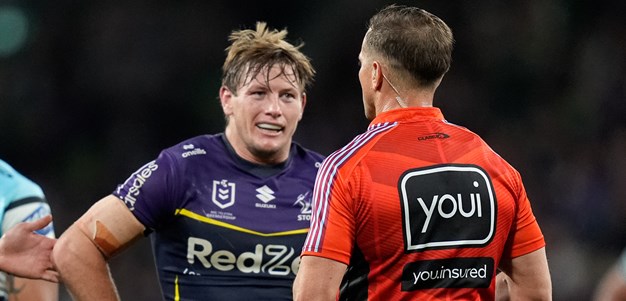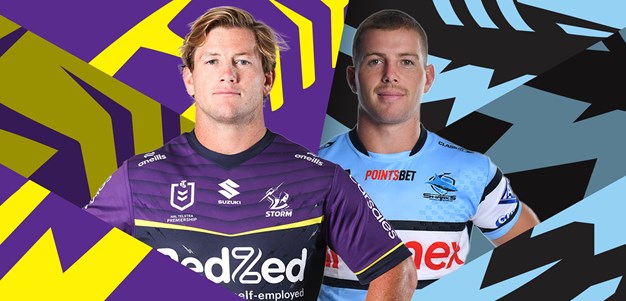
Craig Bellamy and the Melbourne Storm are never very far off the pace, finding a way to be competitive every year if they’re not 100 percent in true premiership contention.
Despite finishing third on the NRL ladder last season, the Storm struggled to elevate themselves into contender status – using 35 players throughout the year (the second most in the NRL) as injuries triggered a regular rotation across the field.
Those injuries led in large part to the relative inconsistency of the side in 2023, which translated into a heavy preliminary final defeat to the Panthers.
But the welcome return of Ryan Papenhuyzen and a month with much of the first-choice 17 on the field has the Storm right back in true premiership contention again.
What the Storm are doing differently
As always, Melbourne's success has begun with an improvement in their defence.
Their 16.9 points conceded per game rank them third in the NRL through eight rounds. It’s difficult to get a read on how much an individual fullback has on team defence, but Papenhuyzen’s experience organising the line is likely to have impacted that improvement following his return this year.
Round 8’s dismantling of the Rabbitohs suggests, most importantly, that the Melbourne attack has also started to find its feet. South Sydney gave away a seven-tackle set in the 25th minute and wouldn't touch the ball again until the 39th minute, with the Storm rolling up the field with relative ease to score four straight tries.
Storm v Rabbitohs – Round 8, 2024
Tellingly, that period provided us with a good idea of how they want their sets to flow and the approach they’re taking to getting up the field.
Off the back of a piggy-back penalty on Papenhuyzen, the Storm were gifted cheap field position to get inside the opposition 20-metre line, where they tend to leave with points more often than any other team. With 151 play-the-balls inside the opposition 20-metre line for 22 tries, they’re the most efficient attacking team inside the opposition 20-metre line in the NRL at 14.6%.
All teams play to a flow with their set starts, with a consistency to them that often goes unnoticed by those at home. For Melbourne, they typically wants to roll to the middle – creating a split for their spine to fire a shot on either side.

Melbourne worked across the field from the tap start following the penalty, using two tackles to get to the middle where they fired a shot down the right edge. The timing is off this time, but a sweeping Papenhuyzen is the target on the second layer – a spot he seems to be finding himself in more often this season.
Papenhuyzen is averaging a career-high 43.4 touches per game and passing the ball more than he ever has. Where he averaged a career-high 11.2 supports in 2020, that number has steadily dropped to the 4.9 supports per game it currently is through seven games in 2024. He’s involving himself more as a ball player across the field to pop up in these spots more often.

As Josh King carts the ball up, picking Damien Cook out in the line to generate momentum, Papenhuyzen doesn’t sweep around the field and look to push up through the middle as he may have done in the past. Instead, he holds the Rabbitohs left edge defence while the rest of the Storm spine attacks the right.

The pass from Grant puts Hughes on the B defender as Trent Loiero’s support on his inside holds up the marker and A. Hughes manages to take a few quick steps as Alec MacDonald attacks the inside shoulder of the C defender.

That shrinks the defence and creates the cue Munster is looking for in the line with Taane Milne jamming in allowing for the over-the-top pass for Coates to score.
Xavier Coates 2nd Try
Melbourne got straight back into their work on the kickoff set for another try only two minutes later, but this one is a little bit different.

Again they take two to the middle of the field, but this one comes via an offload.
Offloads a hallmark of Melbourne’s yardage sets as they generate momentum for their spine to attack behind, with the location of their offloads changing significantly this year. The Storm threw 4.1 offloads per game in the 20 metres either side of halfway in 2023 but have bumped that up to 5.1 in 2024 (second most in the NRL).
Here, Shawn Blore is able to release a pass out the back for Grant to bring Nelson Asofa-Solomona onto the ball. He’s not going to get 20 metres up the field every time, but he’s going to attract three defenders more often than not.

Again, it’s a feature of how the Storm gets up the field. The 38% of carries in which they attract three defenders into the tackle is the third-highest mark in the NRL, up from 14th last season. Importantly, their 3.45 second play-the-ball is the third-quickest on the back of them which creates space.

Melbourne use Asofa-Solomona’s quick play-the-ball to flood the middle with the third man late out of the tackle. They will take this cue more often than not, despite Hughes pleading for the ball down the short side.
He isn’t pleading for long, though.

With nothing on as the Rabbitohs defence sits back and waits for help on the inside, Munster turns Reimis Smith back underneath to reset the play back to the middle, 10 metres in front of the last play-the-ball. It’s an important play. Not only because he generates a quick play-the-ball himself, but it forces Keaon Koloamatangi back to the short side where he is then slow to get up off the line.

Grant again takes the space, the inside support on Hughes again holds up the defence around the ruck, and the halfback is able to create the space out wide for Meaney to break the line and put Will Warbrick over in the corner.
Will Warbrick Try
Soon after, another strong yardage set (featuring an Asofa-Solomona carry and momentum-generating shift to the edge) triggered a quick play-the-ball, which shrunk the line for Munster to kick for Coates in the corner for their third straight try.
A penalty and forced dropout provided them with enough opportunities inside the South Sydney 20 for Grant to burrow over for their fourth and put the game away.
Harry Grant Try
Melbourne are getting back to their best this season, and fast. They’re lethal on the opposition line and are generating momentum through offloads in the middle to get them there. Papenhuyzen’s increased role as a passer and creator allows them to play both sides and stretch the defence at all times.
Importantly, however, they don’t lack inside support with Papenhuyzen sitting wider. That option still remains there for whatever breaks do come through the middle – making their attack one of the more dangerous outfits when it clicks.
The Storm have invested heavily in their spine and they’re proving that, when healthy, they’re a constant threat across the field.
With their ruthless attention to detail and coaching expertise, the Storm will always be among the best in the competition defensively. Now that the attack is catching up and scoring in a variety of ways, they’re dominant on both sides of the ball and placing themselves firmly in the premiership conversation.





